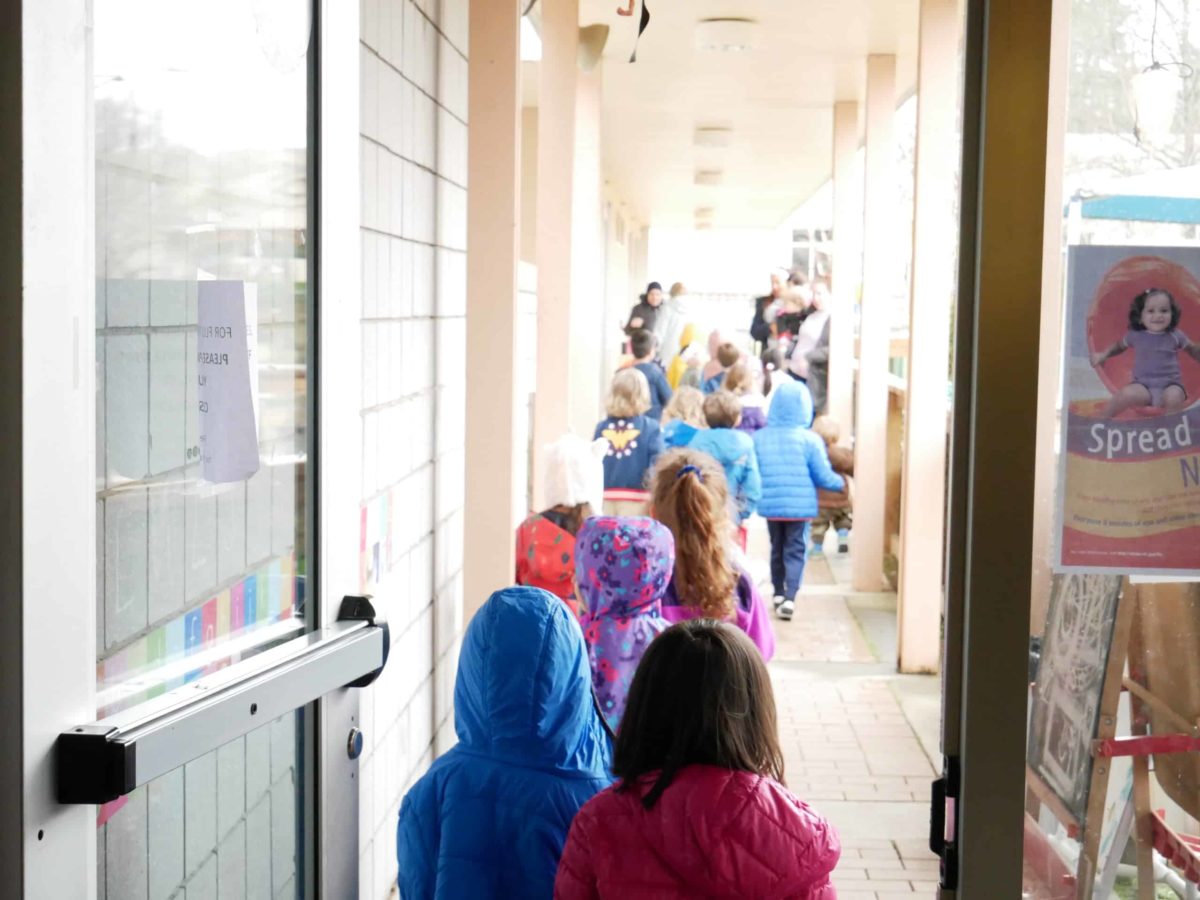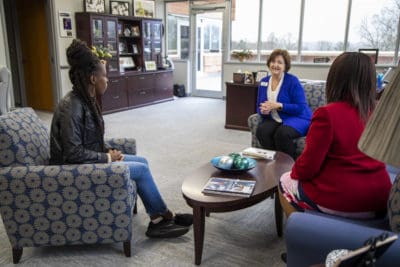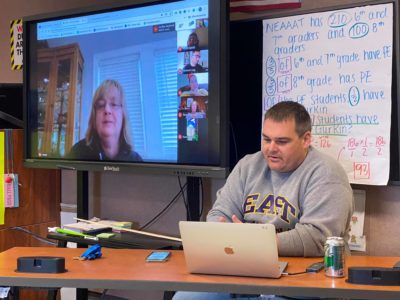

Over the last week, Kristen Idacavage, director of Kids R Kids Learning Academy, a private child care center and elementary school in Charlotte, said her favorite word has become “pivot.”
Amid the ever-changing circumstances and guidance for child care centers during the COVID-19 outbreak, Idacavage has used the word with her teachers and staff repeatedly.
“We’re going to figure out a new way to do things, and if it doesn’t work, we’re going to pivot again,” she said.
Unlike K-12 public schools, early education centers across the state have not been ordered to close to stop the spread of the coronavirus, leaving centers to make the calls on their own. Many remain open.
“I don’t think that we really ever considered closing,” Idacavage said.
Many of the individuals whose children attend the center, she said, cannot work from home — people like doctors, nurses, and policemen.
“It was, how do we move forward and keep everyone as safe as we can and really try to step up and be there for our families and for our employees as well,” she said.
The state Department of Health and Human Services (DHHS) has given centers the option to apply to become emergency child care sites for parents who can’t work from home if they meet certain health guidelines — and will give bonus payments to emergency centers for full-time staff in April and May.
Several early childhood organizations are calling on Gov. Roy Cooper and DHHS Secretary Mandy Cohen to close child care centers, with an exception for those serving children of essential workers. This week, they also called for financial assistance for centers before DHHS announced its most recent financial assistance package Thursday.
“While we’re all talking about how important and essential child care is to families and to our economy, we have to first prioritize the health and safety of the children, the families, the early educators, and the communities that they serve,” said Michele Rivest, policy director of the North Carolina Early Education Coalition. “And allowing them to stay open just creates confusion and adds to the public health risk.”
Rivest said the state’s strategy needs to be more intentional and ensure the centers that could serve as emergency sites for children of essential workers are high-quality. Those that are choosing to remain open, she said, are clamoring for supplies and financial resources as they lose many parents’ tuition dollars.
Rivest said Thursday that the state’s financial package, which will pay teachers $300 a month and other staff $200 a month, does not meet all of centers’ needs.
“What’s missing completely is any mention of providing and paying for all health and safety protective gear and cleaning and sanitizing supplies outside these flat rates,” Rivest wrote in an email. “They need to get these supplies to these programs ASAP as they do not have the ability to purchase or find these funds.”
DHHS has committed to paying centers, regardless of if they stay open, based on February attendance for NC Pre-K and child care subsidy slots. Families with essential workers that need child care options should call 1-888-600-1685 to find an emergency site near them. Essential workers may also qualify for financial assistance with child care for April and May.
Idacavage said her school is gearing up to accept children of critical workers who have been displaced from their normal centers next week and will be filling out the DHHS application to become an emergency site.
Inside the classroom
For Daché Browne, who has worked at Kids R Kids for five years and now teaches a classroom of 3-year-olds, the last month has been full of increasingly rapid change.
“The past two weeks, it’s gotten really real,” Browne said. Listen to Browne’s experience in the classroom — and how she is maintaining a positive attitude going forward — below.
The school has reduced its hours to allow time to disinfect all surfaces and toys. It is doing daily health checks, has reduced some play materials that young children often put in their mouths, has added a car line so that parents are not entering the building, and has taken away high-contact points like check-in screens. The school has also gotten more strict on policies about sick children and adults and when they can return to school.
Browne said about half of her 12-student classroom attended on Tuesday, which makes it easier to separate children when they get close and keep an eye on what they are touching.
“When there’s six of them, it’s easy to catch those little things and be more flexible, so we’ve had a lot more outdoor time … so that we’re not cooped up inside with no fresh air and germs,” she said.
As far as the school’s messaging to parents, Idacavage said the school originally wanted to let parents and families know it was there if they needed care. Now, the messaging has shifted: Keep your children home if you can.
Browne said she is staying positive and focusing on taking proper health precautions, instead of letting stress over contracting coronavirus consume her.
“I haven’t been like that ever in life, so I don’t take that approach, but it is always in the back of your mind,” Browne said.
She said her priority is serving her students’ families during a challenging time — and keeping a sense of normalcy for children. Her 3-year-olds have noticed changes in their routine, Browne said, and are often asking whether their absent classmates are sick.
“It’s explaining, ‘No, they’re not sick, but there are a lot of germs right now, and their mommies and daddies can stay home, and so they’re just keeping them home safe from the germs. And your mommy has to work, but we’re here, and we’re washing your hands, and making sure you’re clean too,'” she said.
As the school applies to become an emergency site, Browne said she is anxious about new students entering the classroom with new germs.
“I think the importance of serving your community and being there for your families is more important than that,” she said. “If we all can just lean on each other, and spread kindness and not spread fear, then we could be that much more beneficial for everyone. There’s always going to be worry and there’s always going to be ‘what if’s?'”
Thinking long-term
Idacavage said she hopes this crisis can shed some light on the importance of early childhood education as a field.
“I really hope that this is a time that we’ll get through it as a country, but I also hope selfishly for our industry that it really can highlight what people do on a daily basis … not just in a time of crisis are we showing up, but that we’re here for families and children,” she said. “Really, I hope that it can kind of elevate our profession, and put some respect on the faces of the people who do this work all the time.”
Rivest said financial support is needed not just for centers that remain open as emergency sites, but for the entire industry. About a third of the state’s child care centers that responded to a survey said they would not be able to reopen if they closed their doors during the pandemic, according to the organizations’ statement.
Early childhood teachers need higher compensation to return to the field as well, Rivest said. In May 2018, the median hourly wage for child care workers was $10.35, according to the Bureau of Labor Statistics.
“We need to be preparing for the long-term impact of this,” she said. “This is a sector that won’t recover quickly, and without significant government financial support, it’s just not possible. It was on the breaking point before. It’s definitely broken now.”
The Hunt Institute, a policy research organization, has compiled a spreadsheet of how different states are responding to the pandemic at all levels of education. Ten states have closed the child care industry so far, while giving certain sites emergency licenses.
Dan Wuori, director of early learning at the organization, said child care workers being put in a “first responder” category with individuals like firefighters and policemen may help society’s perception of the profession down the road.
“This crisis is really bringing into focus a lot of the long-term challenges that the child care industry in particular has faced in a way that will be interesting to watch and see how that translates to longer-term action as this immediate crisis dies down,” Wuori said.




